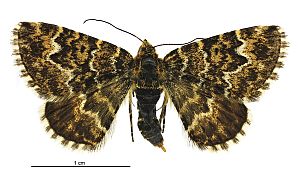Notoreas arcuata facts for kids
Quick facts for kids Notoreas arcuata |
|
|---|---|
 |
|
| Female | |
| Scientific classification | |
| Genus: |
Notoreas
|
| Species: |
arcuata
|
The Notoreas arcuata is a type of geometer moth. These moths are special because they are endemic to New Zealand. This means you can only find them living naturally in New Zealand.
Contents
Discovering the Moth
Scientists give every living thing a special name. This helps them organize and study nature. The Notoreas arcuata moth was first described in 1921. A scientist named Alfred Philpott gave it its name. He used a moth collected by Mr R. Grimmett in the Saint Arnaud Range in New Zealand.
Another famous insect expert, George Hudson, also wrote about this moth. He included it in his book, The Butterflies and Moths of New Zealand. The original moth specimen used to describe the species is called a holotype. It is kept safe at the New Zealand Arthropod Collection.
What Does It Look Like?
The Notoreas arcuata moth is about 27 millimeters wide. Its head, mouthparts (palpi), and body (thorax) are a golden-yellow color. They also have some whitish scales. Its antennae are black with white rings. The rest of its body (abdomen) is black with whitish lines where the body parts join. Its legs are a yellowish-white color, but they are mostly dark. The feet (tarsi) have yellowish rings.
Wings
The front wings are shaped like triangles. They have a rounded tip and curved edges. They are dark brownish-grey and covered with many small yellow specks. The wings have thin white lines, sometimes with a yellow tint. There is a black spot in the middle of each front wing. The back wings look similar to the front wings. However, they do not have the first line near the base. The fringes of hair along the edges of the wings are white with blackish bars.
Underside
The underside of the wings looks like the top side. But the lines are much wider. The area near the front edge of the wings is bright yellow.
Where It Lives
This moth is found only in New Zealand. It was first discovered in the Saint Arnaud Range. It has also been seen in Arthur's Pass.
Life and Habits
The Notoreas arcuata moth can be seen flying during the warmer months. They are active from December to February.
Habitat and What They Eat
These moths live in areas where their food plants grow. The caterpillars of Notoreas moths eat woody plants. They especially like plants from the Kelleria and Pimelea groups. These plants belong to the daphne family.

